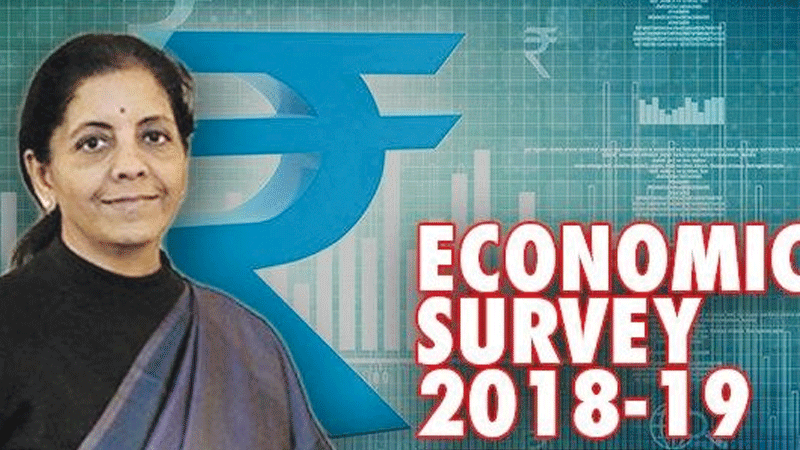The Union Minister for Finance and Corporate Affairs, Smt. Nirmala Sitharaman tabled the Economic Survey 2018-19 in the Parliament on July 4. The Key Highlights of Economic Survey 2018-19 are as follows :
–Survey states that pathways for trickle-down opened up during the last five years; and benefits of growth and macroeconomic stability reached the bottom of the pyramid.
–India needs to grow at 8% per year to be $5 trillion economy by FY25.
–Key ingredients for a self-sustaining virtuous cycle:
–Presenting data as a public good.
–Emphasizing legal reforms.
–Ensuring policy consistency.
–Encouraging behavior change using principles of behavioral economics.
–Investment the “key driver” of simultaneous growth in demand, jobs, exports & productivity
–Rural wage growth started increasing since mid-2018.
–Political stability should push the animal spirits of economy.
–Poor enforcement of contracts and dispute resolution is a big hurdle. Faster legal process should be top priority.
–Savings & growth are positively co-related. Savings must increase more than investment.
–Constant recalibration based on real time data. Data must be created as a public good “of the people, by the people, for the people.
–Success of MGNREGS shows govt schemes can make a difference on the ground with skilful use of technology
–A minimum wage policy for bottom rung of wage earners to drive up demand and strengthening the middle class.
–Indian MSMEs need to be freed from shackles that convert them into dwarfs.
–MSMEs need to be seen as a source of innovation, growth and job creation.
–Policy should enable MSMEs to grow, create greater profits for their owners and contribute to job creation and productivity in the economy .
–India needs to increase per capita energy consumption to raise real per capita GDP by US$ 5000 and improve its HDI ranking.
–India will enjoy the “demographic dividend” phase in the next two decades but some states will start transitioning to an ageing society by the 2030s.
–India moving forward from Swachch Bharat to Swasth and Sundar Bharat.
–The Survey visualises creating a Detroit for Electric Vehicles in India.
–Ease labour laws to spur job growth.
–The Survey seeks reform in lower judiciary
–Govt stands by the fiscal consolidation path.
–Jan-March economic slowdown due to poll related related activity.
–Greenshoots in investment seems to be taking hold.
–NBFC stress reason for FY19 slowdown.
–Decline in NPAs should push up CAPEX cycle.
–General fiscal deficit seen at 5.8% in FY19 VS 6.4% in FY18.
–Investment rate seen higher in FY20 on improved demand.
–Oil prices seen declining in FY20.
–India now stands at 4th in wind power, 5th in solar power and 5th in renewable power installed capacity.
–Rs 50,000 crore saved and 108.28 million tonnes of CO2 emissions reduced by energy efficiency programmes in India.
–Services sector (excluding construction) has a share of 54.3 per cent in India’s GVA and contributed more than half of GVA growth in 2018-19.
–The IT-BPM industry grew by 8.4 per cent in 2017-18 to US$ 167 billion and is estimated to reach US$ 181 billion in 2018-19.
–The services sector growth declined marginally to 7.5 per cent in 2018-19 from 8.1 per cent in 2017-18.


